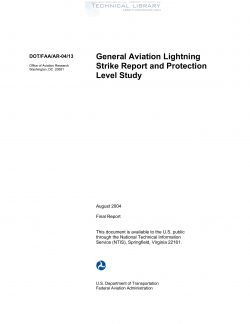DOT-FAA-AR-04-13
- Version
- 304 Downloads
- 1.04 MB File Size
- 1 File Count
- March 5, 2017 Create Date
- March 5, 2017 Last Updated
General Aviation Lightning Strike Report and Protection Level Study

The lightning strike data analysis for the Federal Aviation Administration and the National Institute Of Aviation Research was conducted to study and review lightning strike reports from incidents involving general aviation business jet aircraft. A lightning strike database was compiled from forms filled out by pilots and maintenance personnel along with the corresponding maintenance history Of that aircraft. The general purpose Of the study was to develop a better understanding Of the factors that are most influential in affecting the probability Of electrical damage of in-service aircraft and their systems due to a lightning strike, to assess the cost-effectiveness Of design changes, and to improve reporting and data collection procedures. There were 95 incident reports on various aircraft models in the database that were used in the study. After validating the data, three variables were studied with respect to lightning damage: aircraft age, aircraft flight hours, and the level Of High-Intensity Radiated Field (HIRF) protection. The level Of HIRF protection for each aircraft model in the database was categorized as full protection, avionics protection, or no protection. Reporting Of lightning strike incidents has drastically improved over the last 5 years, indicating the effectiveness of lightning strike incident-gathering procedures. Also, aircraft delivered over the last 10 years have been increasingly equipped with HIRF-protected systems. The data revealed that aircraft were most vulnerable to a lightning strike when flying in clouds and rain. The study found that the amount Of HIRF protection in an aircraft had a significant impact on the extent Of damage resulting from a lightning strike. Compared to unprotected aircraft, HIRF- protected aircraft had a significantly lower percentage Of electrical failures or electrical interference events due to lightning strikes. The study indicated that the age of the aircraft had no observable impact on the percentage Of electrical failures due to lightning strikes. The percentage Of electrical failures from lightning strikes increased for those aircraft with more flight hours.
| File | Action |
|---|---|
| DOT-FAA-AR-04-13 General Aviation Lightning Strike Report and Protection Level Study.pdf | Download |

Comment On This Post